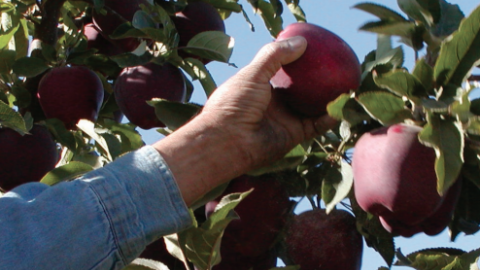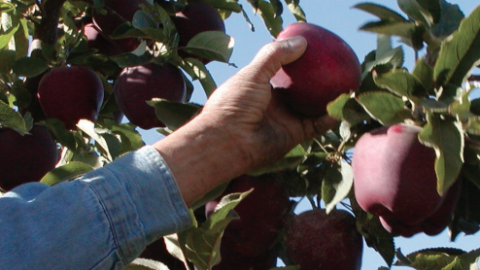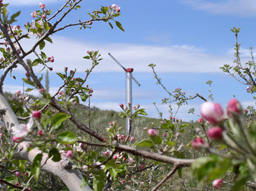
Washington State is the No. 1 apple producer in the U.S. and tree fruit is one of its largest industries. The Pacific Northwest Agricultural Safety and Health Center's (PNASH) research analysis of Washington Labor and Industry records show most injuries in orchards result from working with ladders. Unstable placement, over-extension, slipping while descending, and being struck by a falling ladder are examples of ladder-related accidents. These accidents result in sprains (38%), contusions (26%), fractures or dislocations (12%), and multiple injuries (7%). Orchard injuries alone account for 45-58% of workers compensation claims on Washington farms1.
The Facts
- In Washington State there are more compensation claims by orchard workers than any other type of agricultural worker.
- Every year there are more than 200 hundred injuries associated with ladders.
- Falls consist of 29% of the total claims in agriculture. If you look at tree fruit only, it rises to 36%.
- The most common accidents are falls from the ladder tipping or from the person slipping.
- Falls usually take place from the upper part of the ladder and can result in serious sprains or other injuries.
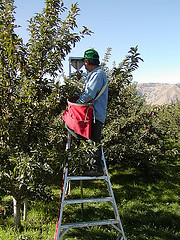
Worker picking apples. Photo by M. Keifer The average time out of work from an accident in an orchard was 150 days.
PNASH Safety Resources
- VIDEO: "Orchard ladders: Life-changing injury stories. Real workers, real events"
This motivational video was produced for farmworkers who work with ladders. It was based on a previous audio story-telling project co-produced by PNASH and Radio KDNA. It was recorded in Spanish with English subtitles and is avaliable on the Ag Centers' Youtube channel. - AUDIO: Workers' Ladder Injury Stories
Listen to real workers discuss stories about falls from ladders, injuries suffered, and the consequences they and their families faced. Mixed in with a talk show aired on Radio KDNA in Granger Washington, these workers share important advice for their fellow farmworkers and supervisors on how to prevent tragic ladder falls. English/Spanish - ARTICLE: Avoiding Ladder Injuries
New devices can help make ladder work safer by Helen Murphy, PNASH Center. Good Fruit Grower | September 2008
PNASH Projects
Heat Exposure, Injury Risk, and Productivity in Agricultural Workers (NIOSH/CDC 2014-2017)
This project aims to examine the association between heat exposure and traumatic injury risk in agricultural workers, the relationship between heat stress and productivity, and the feasibility of using a biomarker of heat acclimation to detect workers at risk for heat-related illness (HRI) and injury.
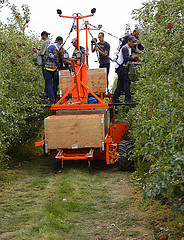
Ergonomic Evaluation and Development of Best Practices for the Use of Mobile Work Platform Technology in Orchards (WA State MAAF 2009-2011, NIOSH/CDC 2011-2012)
Technological advancement is important to American agriculture and will continue to transform work practices and equipment. The PNASH Center worked with the tree fruit industry to develop safety measures for mobile work platforms to prevent potential hazards.
Identification and Prevention of Injuries in Northwest Orchards (NIOSH/CDC, 2001-2007)
This study found that ladders were the leading cause of orchard injuries, accounting for 30% of injury claims and costing $21.5 million over a six-year period. Ladder accidents were a consequence of unstable placement, over-extension of the third leg, slipping while descending, or being struck by a falling ladder. These hazards most commonly resulted in sprains and strains, eye injuries, and fractures and dislocations. Study results were drawn from comprehensive review of injury claims and personal interviews. To solve these problems, three prototype interventions were developed: a new ladder with built-in sensors that can, as a training tool, both warn workers and monitor risk conditions; a modification to a ladder that alerts workers to when they have reached the last step; and a simple plug that stabilizes the third leg.
Research Publications
- Hofmann J, Snyder K, Keifer M. A descriptive study of workers' compensation claims in Washington State orchards. Occup Med (Lond). 2006 Jun;56(4):251-7. Epub 2006 Apr 20. PMID: 16627546
- Salazar MK, Keifer M, Negrete M, Estrada F, Synder K. Occupational risk among orchard workers: a descriptive study. Fam Community Health. 2005 Jul-Sep;28(3):239-52. PMID: 15958882
Other Recommended Safety Resources
- The National Agricultural Safety Database (NASD) is an online collection of information about health, safety and injury prevention in agriculture. The site is maintained by the National Institute for Occupational Safety and Health.
- Oregon State University Extension - Tripod Ladder Safety
Video transcript fact sheet - OSHA Fact Sheet – Safe Use of Tripod Orchard Ladders
Find tips for fall prevention, instructions on safely carrying and moving ladders, how to inspect a ladder, and general safety information. A ladder safety checklist is also included. English or Spanish - NIOSH Ladder Safety app for mobile devices (English/Spanish)
This app features a multimodal indicator and a graphic-oriented guide for ladder selection, inspection, positioning, accessorizing, and safe use. The app is also available in Spanish (to view and use, select Spanish as the phone language) - WSU Extension – Orchard Ladder Safety & Checklist (English/Spanish)
- StateComp Insurance Fund & the California Farm Bureau Federation – Orchard Safety Tree Fruit Video (Spanish)
1 Paradis, R. 2001. Data on Injuries from 1994-98, Region V, Washington State. Washington State Department of Labor and Industries.

